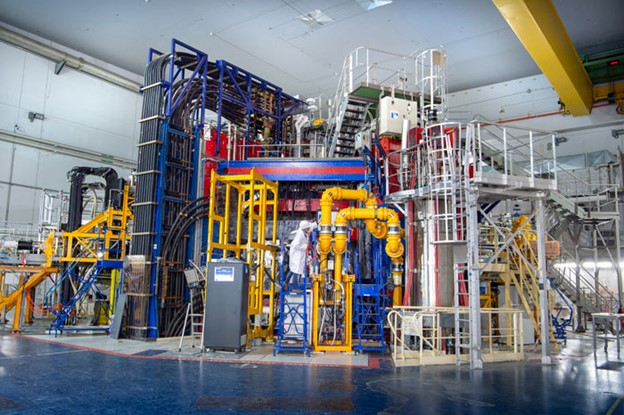
WEST tokamak run by the CEA © L. Godart/CEA
Feb. 18, 2025 — French research organization CEA reported that on 12 February, the CEA’s WEST tokamak maintained a nuclear fusion plasma for more than 22 minutes, a 25 percent improvement over the previous record.
“This leap forward demonstrates how our knowledge of plasmas and technological control of them over longer periods is becoming more mature, and offers hope that fusion plasmas can be stabilised for greater amounts of time in a machine such as the massive ITER tokamak, a machine that confines a plasma using magnetic fields, in Saint-Paul-lès-Durance, France.
The WEST tokamak is run from the CEA Cadarache facility in southern France and is one of the EUROfusion consortium’s medium size tokamak facilities. The previous record time was achieved by EAST, in China, a few weeks previously.
In its announcement, CEA said reaching durations such as these is a crucial milestone for machines like Iter, which will need to maintain fusion plasmas for several minutes. The end goal is to control the plasma, which is naturally unstable, while ensuring that all plasma-facing components are able to withstand its radiation without malfunctioning or polluting it.
This is what CEA researchers intend to achieve and what explains the current record. Over the coming months, the WEST team will double down on its efforts to achieve very long plasma durations – up to several hours combined – but also to heat the plasma to even higher temperatures with a view to approaching the conditions expected in fusion plasmas, according to CEA.
CEA said the WEST facility welcomes researchers from around the world, who make use of its key characteristics that allow long-duration plasmas, particularly its superconducting coils and actively cooled components. WEST is one facet of an international movement comprising other major experiments in which CEA researchers are involved, such as JET, the Joint European Torus tokamak in the United Kingdom (closed in late 2023), which holds the record for fusion energy, JT-60SA in Japan, EAST in China, and KSTAR in South Korea, not to mention the flagship machine that is ITER.
 “WEST has achieved a new key technological milestone by maintaining hydrogen plasma for more than twenty minutes through the injection of 2 MW of heating power. Experiments will continue with increased power. This excellent result allows both WEST and the French community to lead the way for the future use of ITER.”, comment Anne-Isabelle Etienvre, Director of Fundamental Research at the CEA.
“WEST has achieved a new key technological milestone by maintaining hydrogen plasma for more than twenty minutes through the injection of 2 MW of heating power. Experiments will continue with increased power. This excellent result allows both WEST and the French community to lead the way for the future use of ITER.”, comment Anne-Isabelle Etienvre, Director of Fundamental Research at the CEA.
Nuclear fusion is a technology with the ultimate goal of controlling naturally unstable plasma. It uses even fewer resources and less fuel than fission, which was already very concentrated, and does not produce long-lived radioactive waste.
Of the various possible techniques for generating energy, the most advanced is magnetic confinement fusion , where plasma is held in a torus by an intense magnetic field and heated until the hydrogen nuclei fuse. Confinement fusion has been shown by JET to produce fusion power of 15 MW for several seconds.
France, home to both WEST and ITER, is well-placed to house the first prototype nuclear fusion reactor. Nuclear fusion is a source of energy that exploits nuclear reactions, with many possible complementary aspects with nuclear fission energy and associated techniques relating to neutrons and matter, which are well understood.
Nevertheless, given the infrastructure needed to produce this energy on a large scale, it is unlikely that fusion technology will make a significant contribution to achieving net-zero carbon emissions by 2050. For this, several technological sticking points need to be overcome, and the economic feasibility of this form of energy production must still be demonstrated.
France has achieved a significant milestone in nuclear fusion technology by setting a new world record at the CEA Cadarache center. The WEST tokamak sustained a plasma reaction for over 22 minutes, surpassing China’s previous record by 25%. This breakthrough, which involved maintaining a fusion plasma at temperatures of tens of millions of degrees, marks a crucial advancement towards the goal of stable, long-duration fusion reactions. The achievement is celebrated globally as a step closer to realizing fusion energy, potentially offering a limitless and clean energy source.
France has just sustained a fusion reaction for more than 22 minutes, breaking China’s record (from few weeks ago) of 18 minutes. The CEA’s WEST machine was able to maintain a plasma for 1,337 seconds.
There’s a revolution happening right now. This breakthrough is massive — and the world needs to know. We’re on the brink of nearly free, limitless energy, the very foundation that drives technological and scientific advancement.
This leap forward demonstrates how our knowledge of plasmas and technological control of them over longer periods is becoming more mature.



